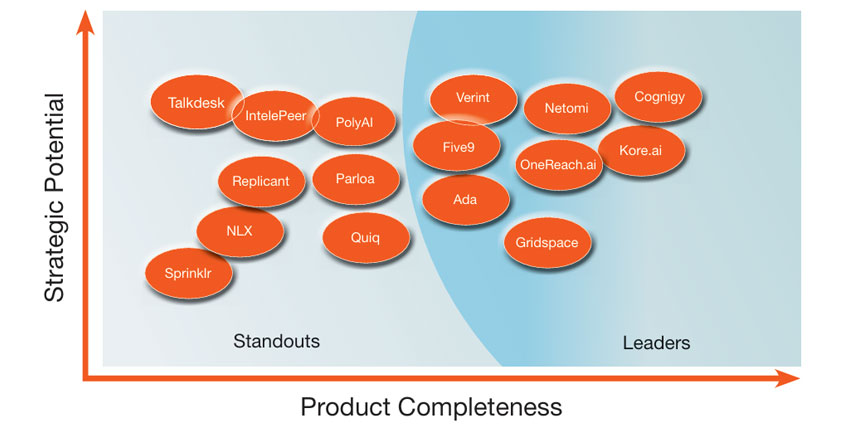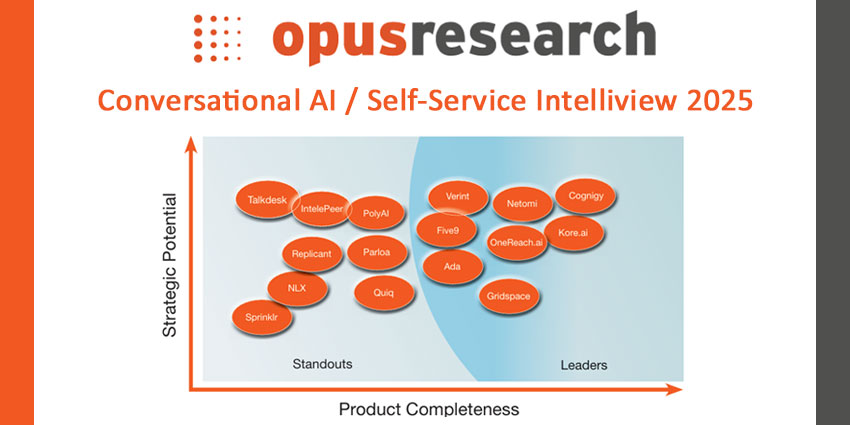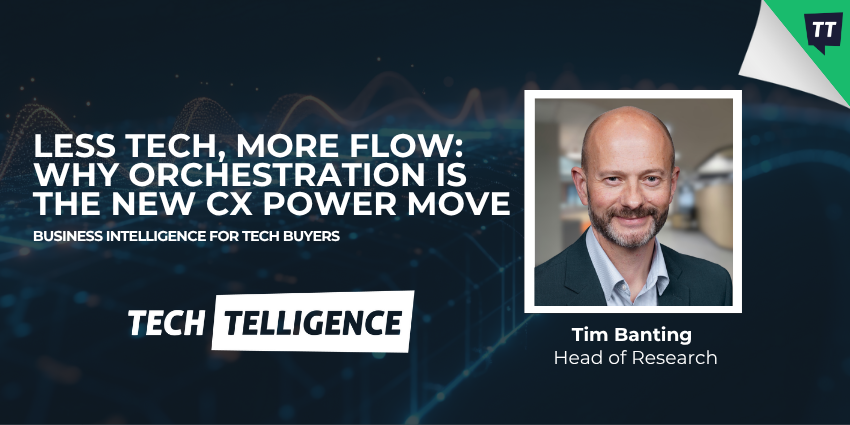The Opus Research Intelliview is a coveted market report that informs enterprise conversational AI / self-service buying decisions.
Like similar market studies, it features a vendor evaluation, taking 16 prominent conversational AI providers and dissecting their solutions, strategy, and services.
Ultimately, that informs the title graphic, which typically attracts most attention.
Yet, the evaluation is just one part of what’s included. The report also unpacks key market trends and considerations for selecting the best-placed vendor.
Ultimately, that sets the stage for the top takeaways below. Yet, let’s first reflect on the evaluation and how Opus placed the vendors on the matrix as it did.
The Opus Research Intelliview Methodology
The Opus Research Intelliview includes 16 global conversational AI players. Each had the opportunity to share details on their products and strategies. From there, the analysts conducted research and observed demos.
As they did so, the analysts focused on each vendor’s product offering, integrations & analytics, safety & trust posture, deployment & maintenance options, and strategy & execution.
That helped Opus formulate scores, while it gave extra credit for unique capabilities and vision.
From there, it placed providers on the following matrix, considering two fundamental questions: How complete is the product? And how strong is the strategy?
However, the research firm stressed that this captures only a snapshot in time. Ultimately, the Intelliview underscores which vendors are doing interesting, differentiated work, without pretending there’s a single “right” way to win in this fast-moving space.
Given that background, here’s how each vendor performed.

Top Takeaways from the Opus Research Intelliview 2025
As noted above, the Opus Research Intelliview not only interrogates prominent conversational AI vendors on their self-service solutions but also offers market commentary and unpacks trends.
The six top takeaways below offer an overview of the study’s major talking points, including extra insight from one of its authors, Ian Jacobs, VP and Lead Analyst at Opus Research.
1. Conversational AI Vendors Are Building Solutions for Two Distinct Buyer Groups
Consider the current customer service landscape. On one end of the spectrum, there is human support, which is relatively high cost but can handle nuance, emotion, empathy, and complexity. On the other, there are entirely scripted, inexpensive chatbots that can’t manage nuance or complexity.
Large language models (LLMs) and generative AI are emerging as the bridge between those extremes, and all three models are still present in the market.
In that dynamic, Jacobs suggests that conversational AI vendors face one massive strategy question:
Should they cater to those ready to go all-in with LLMs and agentic AI, or to those who need incremental steps toward that future?
That divide between all-in and incremental adoption is perhaps the biggest split in the vendor landscape today.
Both approaches are valid, targeting different audiences. Yet, those taking the slower route are often depicted as behind in technology, when that’s not necessarily the case. They simply focus on helping customers start small.
For instance, they might take a five-year-old scripted chatbot and add generative capabilities to the interaction layer, while keeping back-end processes locked down. That’s not massively transformative, but it can deliver significant efficiency gains and build confidence in the tech.
2. Tech Leaders Are Accelerating the Transformation of No-Code Builders
Traditionally, conversational AI vendors emphasized “no-code” flow builders, where businesses plot a step-by-step process for the virtual agent to follow.
These builders were predictable but inflexible, and often time-consuming to master.
Leaders today are offering more flexibility, allowing businesses to mix and match. For example, they may design a locked-down process with a free-flowing dialogue, or vice versa. This allows businesses to tailor the self-service solution to specific intents.
After making this point, Jacobs added:
Some are moving away from traditional flow builders altogether, toward models where you define requirements through prompting, and the system builds the flow in the background.
3. Some Vendors Go Further on Trust & Safety Than Others
Damaging hallucinations, data leaks, and regulatory violations are major concerns when it comes to safeguarding self-service applications.
Some vendors go further here than others. Jacobs suggests leaders excel at:
- Simulation testing with generative AI and automated test case generation.
- Built-in evaluation metrics.
- Inbound protection (e.g., prompt injection detection).
- Outbound monitoring (e.g., preventing harmful responses, hallucinations, or brand guideline violations).
- Continuous monitoring after launch, with alerts for failures, latency spikes, or missed capabilities.
4. Usability and Pricing Models Rise In Self-Service Buying Conversations
Across the conversational AI space, there’s a shift from tools built for technical experts to those designed for business users.
That doesn’t remove the need for IT, governance, and legal teams. Still, it empowers non-technical leaders — for example, contact center managers — to test changes directly in a sandbox without long IT turnaround times.
As those managers become more savvy to the finer details of self-service, the capabilities available to less technical users are a rising consideration for many brands.
That’s alongside pricing models. Currently, there’s no single “best” approach here. However, as Jacobs stated: “Leading vendors can clearly explain why their model benefits target customers and aligns with their needs.”
5. Conversational AI & Conversational Intelligence Go Hand-In-Hand
Jacobs envisions a future where the conversational AI world – understanding what a customer wants, responding, and taking action – isn’t separate from the conversation intelligence world, which analyzes customer conversations individually and in aggregate.
Think of conversational intelligence wrapping around and dissecting insights from all conversations, including those led by humans, AI, and both.
As this happens, a bot interaction that escalates to a human is analyzed holistically, with the contact center able to unpack what happened at that breaking point, the change in sentiment, and other critical intelligence.
In this sense, it’s similar to when the contact center space moved from multichannel to cross-channel to omnichannel service: it’s breaking down silos to create a complete view of the customer journey.
However, some conversational AI vendors Opus Research evaluated are not yet building for this future and unifying analysis across human and AI-driven conversations. Buyers should consider this when assessing possible self-service providers.
6. “Agentic” Is Here Today, Autonomy & Self-Reflection Are for Tomorrow
While not all conversational AI vendors use the term “agentic”, many are building capabilities that fit under the banner.
Today, “agentic” usually means prompt-based bot creation, but many other forms will emerge.
That’s according to Jacobs, who shared two examples:
- Self-Reflection — The virtual agent evaluates its own performance and adjusts behavior without human approval once trust is established.
- Autonomy and Optimization — The bot prioritizes based on brand goals, whether that’s cost, speed, accuracy, or even energy usage, and optimizes its actions accordingly.
“We’re not there yet, but the building blocks exist,” added Jacobs. “These aren’t far-future concepts; they’re logical next steps.”
Critically, they also align with the broader definition of “agentic”, which is about granting agency to automated systems.
Interested in learning more from Jacobs and the Opus Research team? If so, check out the article: What Should You Look for in a Contact Center Virtual Agent?







